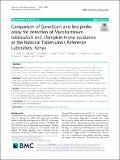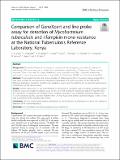| dc.description.abstract | Background: Tuberculosis (TB) remains a major cause of morbidity and mortality worldwide, drug-resistant
tuberculosis being a major public health problem. The emergence and spread of multidrug resistant (MDR)
Mycobacterium tuberculosis complex (MTBC) strains poses significant challenges to disease control. Continued
surveillance of drug susceptibility helps determining proper treatment regimen. The effectiveness of a standard
anti-tuberculosis (TB) treatment regimen correlates with in vitro drug susceptibility pattern of the infecting
tubercle bacilli. The results of the drug susceptibility tests help select a proper treatment regimen or modify
treatment regimen for a better management of patients and surveillance and timely control of the spread of the
drug resistant TB in the community. Treatment of drug resistant TB is costly, and the outcomes, including
survivorship, can be poor. As the result, the drug susceptibility test has become more important than ever.
Objective: This study aimed to investigate the patterns of first line anti-tuberculosis drug-susceptibility against
Mycobacterium tuberculosis complex isolates from new cases of pulmonary TB patients in Kisumu County,
Western Kenya. Method: This was a cross sectional study which included a total of 290 isolates from pulmonary
TB patients in JOOTRH and Kisumu County Hospital between February and August 2016. The MTBC isolates
identified were M. tuberculosis, M. africanum, and M. bovis. Drug susceptibility test was performed on the 283
M. tuberculosis, 5 M. africanum and 2 M. bovis isolates by BD BACTEC MGIT 960 SIRE and PZA DST
system using five first-line anti-TB drugs: Isoniazid, Rifampicin, Streptomycin, Ethambutol and Pyrazinamide.
Results: M. tuberculosis was highly sensitive to all the anti-TB drugs; Streptomycin(S) 96.8%, Isoniazid (H)
89.8%, Rifampin(R) 98.2%, Ethambutol (E) 94.4%, Pyrazinamide (PZA) 89.8%. M. bovis TB species was 100%
sensitive to all drug except Pyrazinamide where there was 100% resistance. M. africanum varied in its sensitivity
to anti-TB drugs; Streptomycin 80%, Isoniazid 60%), Pyrazinamide 4 (80%). Resistance was Streptomycin 20%,
Isoniazid 40%, and Pyrazinamide 20%. M. africanum was neither resistant to Rifampin(R) nor Ethambutol (E).
A total of 20.8% of M. tuberculosis strains showed resistance to at least one drug tested, while 79.2% were
sensitive. 16.3% were resistant to one drug (mono resistance), 2.1% to two drugs (double resistance), 0.7% to
three drugs (triple resistance), 0.4% to four drugs (quadruples) and 1.4% to five drugs (pentagon-resistance).
Two isolates of M. bovis were resistant to one drug. Two isolates of M. africanum were resistance, one case to
one drug and another one case to three drugs. Conclusion: This study showed high level of resistance in M.
tuberculosis isolates warranting proper use of anti-TB drugs in Kisumu County. | en_US |


